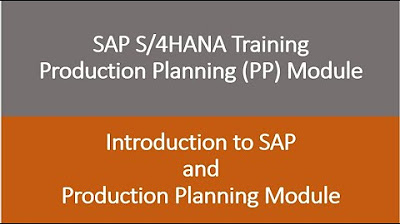03. Production Planning - Theory
Summary
TLDRThis video provides an in-depth introduction to the Production Planning module (PP) in the SAP ERP system, focusing on how it helps businesses optimize production schedules, forecast material needs, and control product quality. The video covers key concepts such as production planning, manufacturing execution types, organizational structures, and master data. It also highlights the integration of PP with other modules like Sales and Distribution, Material Management, and Financial Accounting, demonstrating its critical role in streamlining production processes and improving overall efficiency. Case studies and examples help illustrate real-world applications in various industries.
Takeaways
- 😀 The Production Planning (PP) module in SAP ERP helps companies schedule production, optimize capacity, predict material needs, and control product quality.
- 😀 The PP module is divided into key components, including production planning, manufacturing execution, and industrial production processes.
- 😀 There are three types of Manufacturing Execution: Discrete Manufacturing (producing different models in batches), Repetitive Manufacturing (producing the same items continuously), and Kanban (managing materials flow).
- 😀 Organizational structure in PP includes clients, company codes, plants, storage locations, and work centers.
- 😀 Plants in SAP can have multiple storage locations such as raw materials, semi-finished goods, finished goods, and miscellaneous items.
- 😀 Work Centers are where production processes add value to materials, such as assembly or packaging areas.
- 😀 Product structure in PP includes different components that form finished products, with multiple levels, like bicycles and accessories.
- 😀 Master data is crucial in PP and includes material master data, bill of materials (BOM), routing (production process steps), work centers, and product groups.
- 😀 Production planning involves both strategic and detailed planning stages, including forecasting, sales and operations planning (S&OP), and material requirements planning (MRP).
- 😀 Manufacturing Execution involves steps like creating production proposals, capacity planning, scheduling, releasing orders, material consumption, and order settlement.
- 😀 Integration of the PP module with other SAP modules, such as SD (Sales and Distribution), MM (Material Management), FI (Financial Accounting), and CO (Controlling), ensures efficient operations across production, sales, and finance.
Q & A
What is the purpose of the Production Planning (PP) module in ERP?
-The purpose of the Production Planning (PP) module is to help companies plan their production schedules, optimize production capacity, predict raw material and spare parts needs, and control product quality during production.
What are the main types of Manufacturing Execution in the PP module?
-The three main types of Manufacturing Execution are: 1) Discrete Manufacturing, where companies produce different materials in batches (e.g., Apple making various Mac models). 2) Repetitive Manufacturing, where the same material is produced continuously over long periods (e.g., Intel producing microchips). 3) Kanban, a system that controls the flow of materials required during production.
How is the organizational structure of an ERP system in the PP module defined?
-The organizational structure of the ERP system in the PP module includes: 1) Client, which represents the entire enterprise. 2) Company Code, representing branches or subsidiaries. 3) Plant, which is responsible for various functions in production. 4) Storage Location, where materials are stored. 5) Work Center, where production processes take place.
What is the role of Master Data in the PP module?
-Master Data in the PP module plays a critical role in ensuring accurate production planning and execution. Key Master Data elements include: Material Master Data, Bill of Materials (BOM), Routing, Work Centers, and Product Groups.
What is the significance of a Bill of Materials (BOM) in the PP module?
-A Bill of Materials (BOM) identifies all the components and raw materials needed to produce a finished product. It helps in ensuring that the right materials are available for production at the right time.
What does the Routing process entail in production planning?
-Routing defines the steps and operations necessary to manufacture a product. It specifies what operations are needed, where they are to take place, when they should occur, and how they should be performed.
What is the purpose of the Master Production Scheduling (MPS) in the PP module?
-Master Production Scheduling (MPS) focuses on scheduling production for top-level items in the BOM. It helps companies plan production to meet demand and ensure that resources are available when needed.
How is Sales and Operations Planning (SOP) integrated with the PP module?
-Sales and Operations Planning (SOP) in the PP module helps forecast demand, determine inventory needs, and generate operational plans to meet sales goals. It integrates with PP by informing the production planning process based on expected sales.
What role does Capacity Planning play in Manufacturing Execution?
-Capacity Planning ensures that the required resources, such as tools, manpower, and equipment, are available to meet production demands. It checks whether the production capacity is sufficient to fulfill orders.
How does the PP module integrate with other ERP modules like SD, MM, and FI?
-The PP module integrates with several other ERP modules to streamline processes: 1) With SD (Sales and Distribution) for checking material availability and meeting sales orders. 2) With MM (Material Management) for managing raw material flows. 3) With FI (Financial Accounting) for tracking production costs and payments.
Outlines

This section is available to paid users only. Please upgrade to access this part.
Upgrade NowMindmap

This section is available to paid users only. Please upgrade to access this part.
Upgrade NowKeywords

This section is available to paid users only. Please upgrade to access this part.
Upgrade NowHighlights

This section is available to paid users only. Please upgrade to access this part.
Upgrade NowTranscripts

This section is available to paid users only. Please upgrade to access this part.
Upgrade NowBrowse More Related Video

SAP PP Training for Beginners: A Complete Guide | Proexcellency

03. Production Planning - Theory

Video 01 - SAP S/4HANA Production Planning (PP) Module training - Introduction to SAP and PP

What is SAP PP? Beginner’s Guide to Production Planning (2025)

01. Sales & Distribution - Theory

04. Financial Accounting - Theory
5.0 / 5 (0 votes)